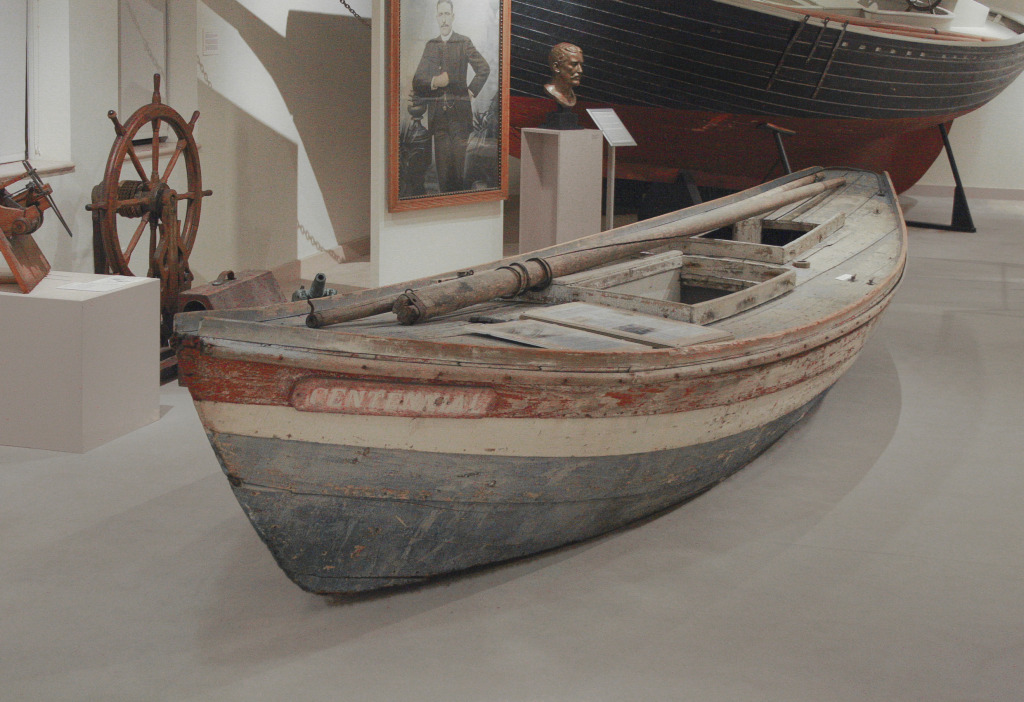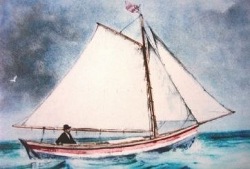
1876 was a big year for the United States. The anniversary of the country’s centennial, there was much hoopla and cause for celebration. To celebrate this milestone, a 29-year old fisherman from Gloucester, Alfred Johnson, sought to do what no man in recorded history had done before – a solo sail across the Atlantic ocean. Allegedly, Johnson and his friends were playing cards and began to discuss whether anyone could cross the ocean alone in a small, open boat. Spurred by this his friends’ disbelief that such a feat could be possible, Johnson declared that not only could it be done, but he would be the one to do it. He purchased a 16-foot dory, named it “Centennial” for the country’s milestone birthday, and set sail on June 15, 1876. After a stop in Nova Scotia, Alfred “Centennial” Johnson sailed into open water on June 25th.
Local fishermen, who heard of Johnson’s proposed trip, thought it a hoax. Passing ships were concerned to find the solo man sailing a small boat in open water and attempted to rescue Johnson who politely refused (much to the crews’ confusion). A German passenger ship even threw Johnson a few bottles of brandy (this he accepted).
On August 12, Johnson arrived in Abercastle, Wales where he rested for a few days. On August 21, he arrived (to much hullabaloo) in Liverpool. And so, Alfred Johnson completed the first solo sail across the Atlantic Ocean. When later asked about the trip, Johnson replied “I made that trip because I was a damned fool, just as they said I was.”

Johnson spent about $200 on a specially designed dory and provisions. He dubbed the boat “Centennial.” The wooden vessel was 20 feet long on deck, 16 feet at the keel, 5 1/2 feet wide and 2 1/2 feet tall. It had a centerboard to keep from sliding sideways. It had three water-tight compartments. Johnson carried a canvas mainsail, two jibs, a square sail, chart, compass, quadrant, medicine, a sea anchor for holding the bow into the wind when not sailing, and a lantern he hoisted at night to keep vessels from running him down. He packed canned meats, condensed milk, fruit, hard bread, tea and coffee. He carried 60 gallons of water and rigged an awning to catch rainwater to replenish his supply. Johnson planned to follow the course to Liverpool plied by ocean steamers and make the nearly 3,000-mile crossing in less than 90 days. He would sail to England and back and then exhibit the vessel in the grand Centennial Exposition in Philadelphia. He believed he was just the man to pull it off. Johnson (sometimes spelled Johnsen) was born in Denmark on Dec. 4, 1846, but ran away to the sea when he was a teen-ager, working aboard square-riggers.
 He fished out of Gloucester for seven years before he attempted the Atlantic crossing. “He is not a man of an enthusiastic temperament as one would naturally suppose a person to be who had such a perilous trip in view,” the Cape Ann Advertiser reported before Johnson left, “neither is he sanguine, but is quite reserved, and from his general appearance gives evidence that he is cautious, and in the habit of giving any subject in which he is interested due consideration before making up his mind.” Many thought him foolhardy. Friends tried to talk him out of it. But about two years after Johnson first proposed the idea, a large crowd gathered along Gloucester’s wharves to watch him sail from the Higgins & Gifford wharf, now Parker Street, at 4:15 p.m. on June 15, 1876. Several yachts and many small rowboats followed him to the Eastern Point breakwater.
He fished out of Gloucester for seven years before he attempted the Atlantic crossing. “He is not a man of an enthusiastic temperament as one would naturally suppose a person to be who had such a perilous trip in view,” the Cape Ann Advertiser reported before Johnson left, “neither is he sanguine, but is quite reserved, and from his general appearance gives evidence that he is cautious, and in the habit of giving any subject in which he is interested due consideration before making up his mind.” Many thought him foolhardy. Friends tried to talk him out of it. But about two years after Johnson first proposed the idea, a large crowd gathered along Gloucester’s wharves to watch him sail from the Higgins & Gifford wharf, now Parker Street, at 4:15 p.m. on June 15, 1876. Several yachts and many small rowboats followed him to the Eastern Point breakwater.
Then he sailed out of sight.